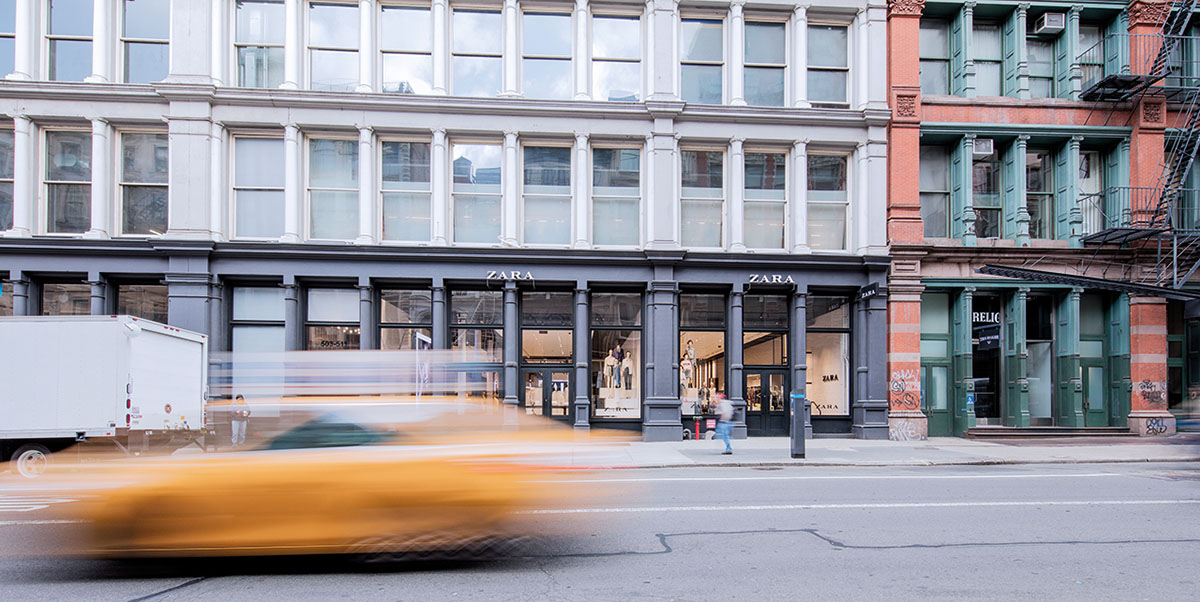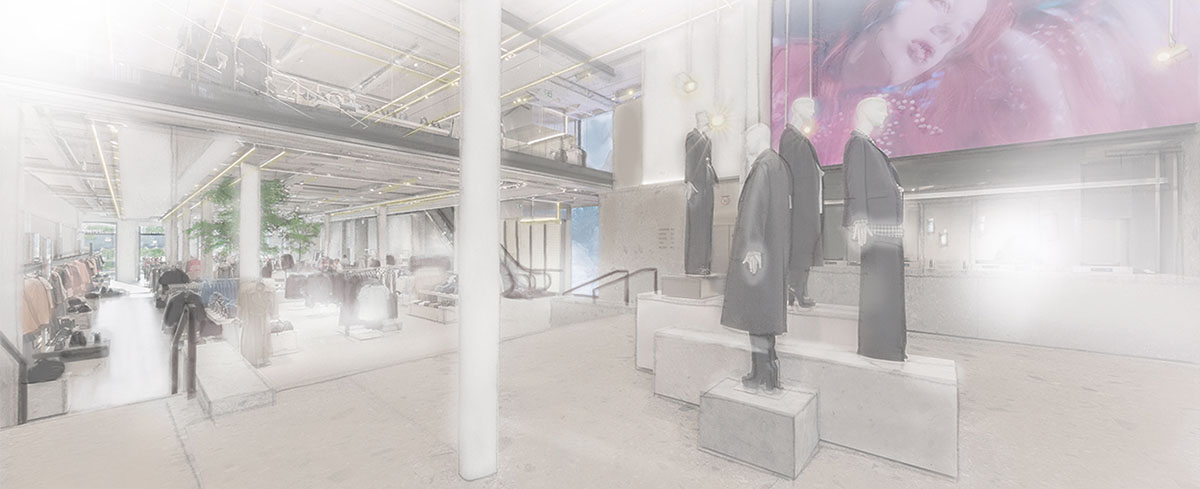1. SUSTAINABLE ENVIRONMENTAL MANAGEMENT OF OUR FACILITIES
In order to fulfil our commitment to manage our resources more efficiently, we believe it is essential to continue investing in facilities and infrastructure. In 2016, the Group invested € 1.4 billion, although over the last five years the amount exceeded € 7 billion. Guided by sustainability goals, these investments include:
- -Expand, size and modernize logistic facilities and design centres.
- Add and refurbish new or existing stores to the Group’s eco-efficiency model.
- Research and development (R&D) of sustainable technologies for stores, such as mobile payments or RFID, that eliminates the need for paper receipts.
- Launch Closing the Loop.
Our commitment to efficiency goes beyond investment in infrastructure and technology and takes the form of an investment in clean energy as well. In 2016, we procured 520 million kWh of renewable energy for our offices, logistic centres and stores. This combined with the renewable generation, tri-generation and co-generation at our facilities means that 30% of the energy we consume is clean, avoiding emissions derived from the production of energy using fossil fuels. Furthermore, we have increased the use of electricity from renewable sources in our facilities tenfold since 2013. In Spain, where the Inditex Group is headquartered, 89% of the electricity consumed comes from renewable sources.

LOGISTIC CENTRES AND OFFICES
Our logistic centres play a key role in our effort to contribute to the sustainability of our clothing, and therefore they, together with our headquarters and offices, constitute a basic pillar of our environmental strategy. All of them have an ISO 14001 certified environmental management system based on continual improvement that allows us to manage efficiently and responsibly.
This year, we expanded Pull&Bear’s headquarters, located in Narón (Galicia). Built following sustainability criteria, the new offices have received the LEED Gold level certification, a standard also achieved by the Oysho headquarters in Tordera (Catalonia). This brings the number of Inditex headquarters and centres that are certified to this sustainable building standard to seven. Also noteworthy is the ISO 50001 certification of the Inditex Technology Centre in Arteixo (Galicia), which is in addition to its current Tier IV and LEED Platinum certifications. The ISO standard validates its energy management and promotes more efficient and sustainable energy consumption.
In an ongoing effort to cut back on the resources we use, this year we continued implementing the Efficiency Plan at logistics centres. By deploying more efficient technology like LED lights or state-of-the-art batteries, we curb energy requirements while improving our efficiency. These actions have led to a 14% drop in electricity consumed per garment as compared to 2015.
On logistics, the multi-shuttle areas started working in Bershka platform in Tordera (Barcelona) and the Arteixo (A Coruña) distribution centre in 2016. The systems led to increased efficiency and accuracy for shipping management and cut box transfer, storage and retrieval times by half.
With regards to training, we continue to develop specific programmes designed to raise awareness among employees about how to use resources efficiently and respect the environment. Notable is our Good Office Practices Handbook, which has successfully sparked campaigns to reduce consumption of disposable bottles, cups and containers, replacing them with reusable options like water bottles and glass and ceramic cups.

ECO-EFFICIENT STORES
Our stores represent the part of our commitment to environmental sustainability most visible to customers. For that reason, we apply eco-efficiency criteria to our stores with a firm commitment that 100% of our commercial footprint meet these requirements by 2020. In comparison to a conventional store, eco-efficient stores reduce electricity consumption by up to 20%. We also manage to use up to 40% less water. Additionally, we reduce our electricity consumption by an estimated 40% by installing state-of-the-art HVAC systems, which also allowed us to eliminate the associated emissions.
As a management tool, at Inditex we have the Eco-Efficient Store Manual, which contains the environmental efficiency requirements our stores must meet from the design phase through subsequent upgrades, once the facilities need to be updated to continue to be in line with the Manual’s strict criteria.
The Eco-Efficient Store Manual lays out the technical requirements and efficiency specifications that should be met by the different installations: lighting, electrical systems, HVAC, plumbing, construction materials or furniture. It also describes how daily operations like waste management should be carried out to ensure efficiency and reduce resource consumption.
In addition, we have a centralized platform that connects to and monitors the HVAC and electrical systems in a total of 2,246 Group stores. The platform, which can be controlled from a tablet, tracks each individual store, giving a real-time snapshot of the resource consumption of its different systems. It can also correct any incidents and maximize efficiency.
Our centralized system for eco-efficient stores allows us to regulate lighting, HVAC, air quality and demand for energy based on occupancy parameters and the time of day.
Additionally, and as a sign of our commitment to renewable energy, we increased the amount of electricity we purchase from certified renewable sources to mitigate the impact of our electricity consumption while reducing the emissions produced by power generation. In 2016, we reached a total of 520 million kWh in our Spain and Germany offices, keeping more than 165,000 tons of CO2 and greenhouse gases out of the atmosphere.
In line with the criteria of our Forest Product Policy, all wood-based products used in our stores have a sustainable forest certification. All furniture and paper products, including paper bags and labels, are PEFC or FSC approved to guarantee that the entire process of producing forest-based raw materials occurs in a sustainable and controlled manner. With the goal of reducing paper consumption, our brands joined the Paperless initiative, which uses electronic receipts for online orders and payments by mobile phone.
LEED and BREAM certified stores, LOGISTIC CENTRES and headquarters
| LEED PLATINUM / GOLD | CURRENTLY IN THE PROCESS OF CERTIFICATION | BREAM | |
| EUROPE | |||
| Zara, Via del Corso, Rome | |||
| Zara, Serrano, Madrid | |||
| Zara, Oxford St, London | |||
| Pull&Bear, Lijnbaan, Rotterdam | |||
| Bershka, Tauentzienstrasse, Berlin | |||
| Bershka, Colón, Valencia | |||
| Zara Portal de l’Angel, Barcelona | |||
| Zara, Champs Elysées, Paris | |||
| Zara, Kalverstraat, Amsterdam | |||
| Zara Haas Haus, Vienna | |||
| Zara, Rynek Glowny, Krakow | |||
| Zara, Place du Molard, Geneva | |||
| Zara Home, Champs Elysées, Paris | |||
| Zara Home, Fürstenfelder, Munich | |||
| Pull&Bear, Gran Vía, Madrid | |||
| Massimo Dutti, Serrano, Madrid | |||
| Massimo Dutti, Paseo del Borne, Palma de Mallorca | |||
| Massimo Dutti, San Feliu, Palma de Mallorca | |||
| Oysho, Paseo de Gracia, Barcelona | |||
| Inditex Technological Centre, Arteixo | |||
| Massimo Dutti Logistic Centre, Tordera | |||
| Cabanillas Logistic Centre, Guadalajara | |||
| Massimo Dutti Offices, Tordera | |||
| Inditex Head Offices, Arteixo | |||
| Oficinas Pull&Bear, Narón, A Coruña | |||
| Oysho Offices, Tordera, Barcelona | |||
| Zara Plaza Cataluña, Barcelona | |||
| Zara Miami, Florida | |||
| Zara Opera, Paris | |||
| Zara Karl Johansgate, Oslo | |||
| Zara Calle Compostela, A Coruña | |||
| Zara Paseo de la Castellana, Madrid | |||
| Oysho Galleria Colonna, Rome | |||
| Oysho Diogonal, Barcelona | |||
| Oysho Rivoli, Paris | |||
| Tempe Technological Centre, Elche | |||
| ASIA AND THE REST OF THE WORLD | |||
| Zara West Nanjing Road, Shanghai | |||
| Zara Bourke, Melbourne | |||
| AMERICA | |||
| Zara Madero, Mexico | |||
| Zara SoHo, New York | |||
